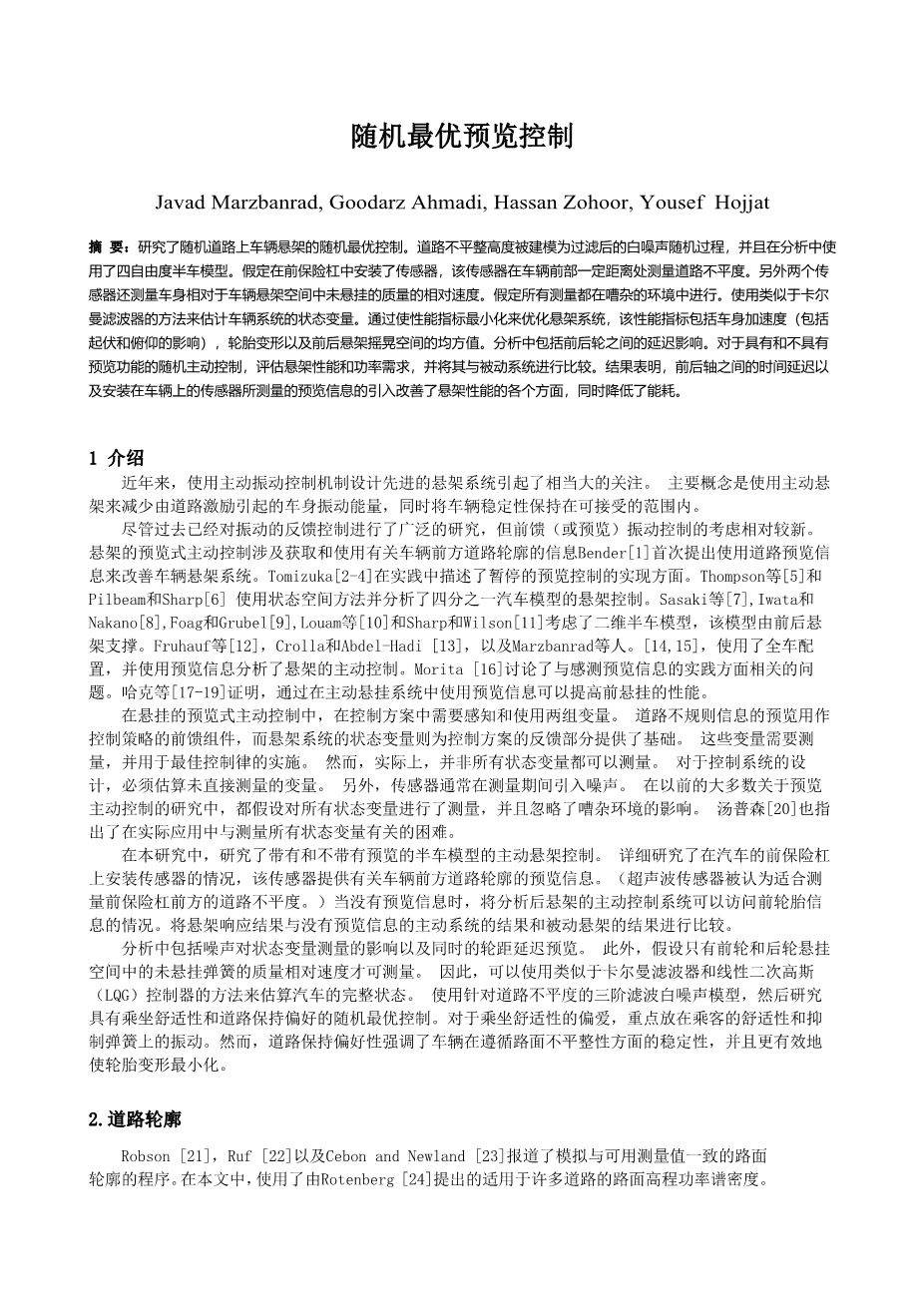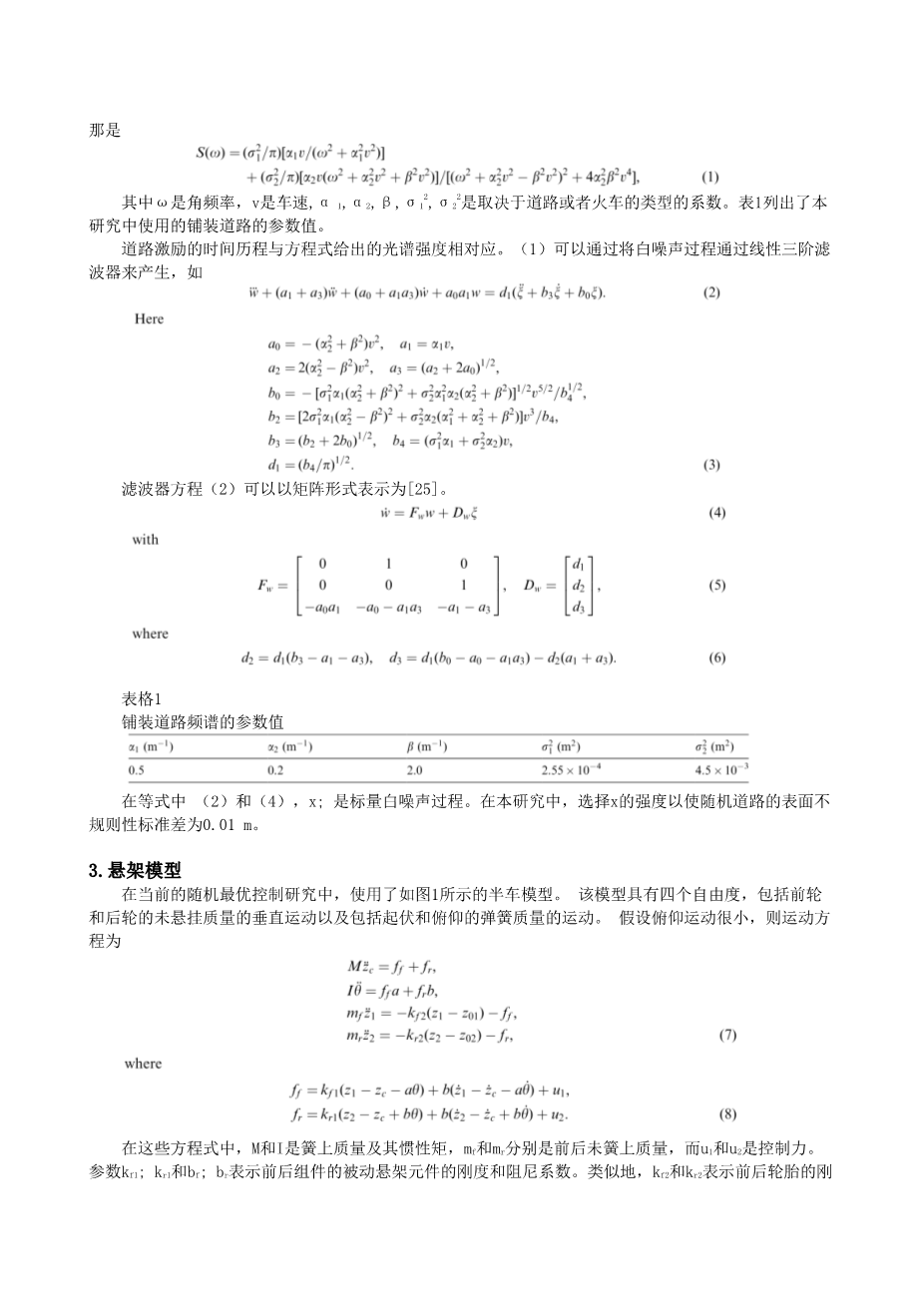JOURNAL OF SOUND AND VIBRATION
Journal of Sound and Vibration 275 (2004) 973–990
Stochastic optimal preview control of a vehicle suspension
Javad Marzbanrada,b, Goodarz Ahmadib,*, Hassan Zohoorc, Yousef Hojjatd
a Department of Automotive Engineering, Iran University of Science and Technology, Tehran, Iran
b Department of Mechanical and Aeronautical Engineering, Clarkson University, Camp Building, P.O. Box 5725,
Potsdam, NY 13699-5725, USA
c Department of Mechanical Engineering, Sharif University of Technology, Tehran, Iran
d Department of Mechanical Engineering, Tarbiat Modarres University, Tehran, Iran
Received 1 May 2001; accepted 3 July 2003
Abstract
Stochastic optimal control of a vehicle suspension on a random road is studied. The road roughness height is modelled as a filtered white noise stochastic process and a four-degree-of-freedom half-car model is used in the analysis. It is assumed that a sensor is mounted in the front bumper that measures the road irregularity at some distances in the front of the vehicle. Two other sensors also measure relative velocities of the vehicle body with respect to the unsprung masses in the vehicle suspension spaces. All measurements are assumed to be conducted in a noisy environment. The state variables of the vehicle system are estimated using a method similar to the Kalman filter. The suspension system is optimized by minimizing the performance index containing the mean-square values of body accelerations (including effects of heave and pitch), tire deflections and front and rear suspension rattle spaces. The effect of delay between front and rear wheels is included in the analysis. For stochastic active control with and without preview, the suspension performance and the power demand are evaluated and compared with those of the passive system. The results show that the inclusion of time delay between the front and rear axles and the preview information measured by the sensor mounted on the vehicle improves all aspects of the suspension performance, while reducing the energy consumption.
r 2003 Elsevier Ltd. All rights reserved.
- Introduction
Using active vibration control mechanisms for design of advanced suspension system has attracted considerable attention in recent years. The main concept is use an active suspension to
*Corresponding author. Tel.: 1-315-268-6586; fax: 1-315-268-6438.
E-mail addresses: marzban@iust.ac.ir (J. Marzbanrad), ahmadi@clarkson.edu (G. Ahmadi), zohoor@sharif.ac.ir (H. Zohoor).
0022-460X/$ - see front matter r 2003 Elsevier Ltd. All rights reserved. doi:10.1016/S0022-460X(03)00812-5
reduce the vibration energy of the vehicle body induced by the road excitation, while keeping the vehicle stability within an acceptable limit.
While feedback control of vibrations has been extensively studied in the past, consideration of feed-forward (or preview) vibration control is relatively new. Preview active control of suspension involves the acquisition and use of information concerning the road profile ahead of the vehicle. Use of road preview information for improving vehicle suspension system was first proposed by Bender [1]. Tomizuka [2–4] described the implementation aspect of the preview control of suspension in practice. Thompson et al. [5], and Pilbeam and Sharp [6] used a state space approach and analyzed the suspension control for a quarter car model. Sasaki et al. [7], Iwata and Nakano [8], Foag and Grubel [9], Louam et al. [10], and Sharp and Wilson [11] considered a two- dimensional half-car model, which is supported by front and rear suspensions. Fruhauf et al. [12], Crolla and Abdel-Hadi [13], and Marzbanrad et al. [14,15], used a full-car configuration and analyzed the active control of suspension with the use of preview information. Morita [16] discussed the problems associated with the practical aspect of sensing the preview information. Hac et al. [17–19] proved that the front suspension performance improves by the use of the preview information in an active suspension system.
In preview active control of suspension, there are two sets of variables that need to be sensed and used in the control scheme. Preview of road irregularity information is used as the feed- forward component of the control strategy, while the state variables of the suspension system provide the basis for the feedback part of the control scheme. These variables need to be measured and be used in the implementation of the optimal control law. In practice, however, not all of the state variables can be measured. For the design of the control system, the variables that are not measured directly must be estimated. In addition, sensors commonly introduce noise during the measurement. In most previous studies on preview active control, it was assumed that all state variables are measured and the effect of the noisy environment was ignored. Thompson [20] also noted the difficulties associated with measuring all state variables in practical applications.
In the present study, active suspension control of a half-car model with and without
剩余内容已隐藏,支付完成后下载完整资料


英语译文共 13 页,剩余内容已隐藏,支付完成后下载完整资料
资料编号:[239011],资料为PDF文档或Word文档,PDF文档可免费转换为Word


